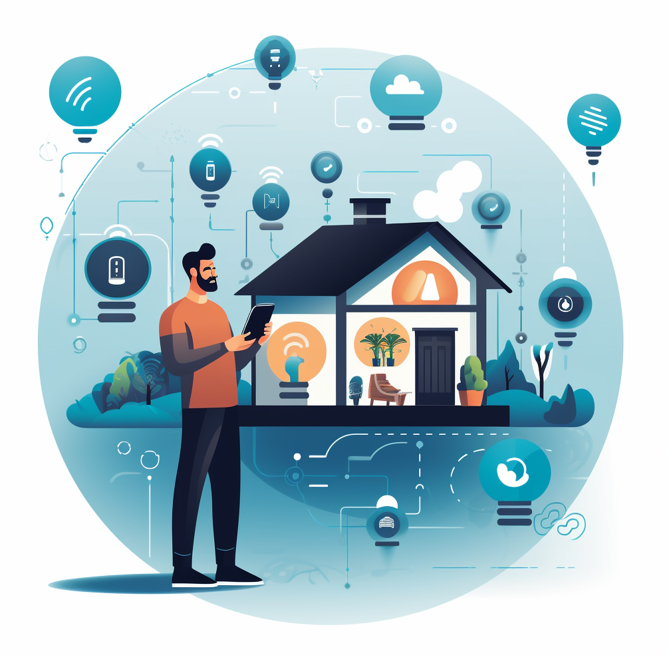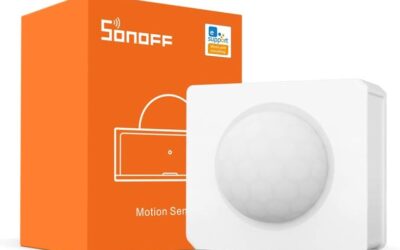Smart Homes 101: What You Need to Know Before You Begin
Table of Contents
- What is a Smart Home?
- Definition and Concept
- The Benefits of a Smart Home
- Convenience, Energy Savings, and Security
- Choosing the Right Ecosystem
- Google Home, Amazon Alexa, Apple HomeKit, and Other Options
- You’ll Want a Hub
- Central Control for Your Smart Home
- The Importance of Smart Speakers and Smart Displays
- Enhancing Control and Interactivity
- The Importance of Wi-Fi
- Backbone of Your Smart Home Network
- Understanding Wi-Fi Frequencies: 2.4 GHz vs. 5 GHz
- Wi-Fi 6E: The Future of Wi-Fi
- Dealing with Wi-Fi Congestion and Router Limitations
- Bluetooth, Wi-Fi, or Smart Hubs?
- Device Connectivity Options
- Verify Smart-Home Support
- Ensuring Compatibility with Your Ecosystem
- Understanding Smart-Home Standards
- The Role of Standards in Smart Homes
- Introducing Matter: The New Wireless Interoperability Standard
- Setting Up Smart-Home Devices
- Initial Setup and Configuration
- Linking to Your Chosen Ecosystem
- Simplified Controls with Ecosystem Apps
- Find Good Spots and Pick Names Carefully
- Device Placement and Naming Conventions
- Grouping, Automation, and Routines
- Simplifying Device Control
- Automating Your Smart Home
- What to Do When You Move or Change Routers
- Transitioning Your Smart Home
- A Word on Security
- Privacy Concerns with Smart Devices
- Multi-Factor Authentication and Other Security Measures
- Troubleshooting Tips
- Common Issues and How to Resolve Them
- Conclusion
- The Future of Smart Homes
Smart homes have become an integral part of modern living, offering convenience, efficiency, and a touch of futuristic allure. This comprehensive guide walks you through the essentials of building a smart home. From understanding the basics to choosing the right ecosystem and tackling technicalities, you’ll find all the information you need.
What is a Smart Home?
A smart home is a dwelling equipped with devices and systems that enable remote control and automation, enhancing comfort, energy efficiency, and security. These devices can include smart thermostats, lights, locks, cameras, and more. The central idea is to create an environment where everyday tasks are simplified through automation and remote control.
The Benefits of a Smart Home
Smart homes offer a multitude of benefits. Convenience is at the forefront, allowing homeowners to control various aspects of their home, such as lighting, temperature, and security, with a simple touch or voice command. Energy savings are significant, as smart systems can optimize energy usage, reducing utility bills. Enhanced security is another advantage, with features like smart locks and surveillance systems providing peace of mind.
Choosing the Right Ecosystem
Selecting the appropriate ecosystem is a pivotal decision in your smart home journey. It determines how your devices will communicate and work together. Let’s explore some popular ecosystems:
Google Home
Google Home integrates smoothly with Google Assistant, offering compatibility with a wide array of devices. This ecosystem is known for its user-friendly approach and voice control capabilities.
Amazon Alexa
Alexa, Amazon’s virtual assistant, powers this ecosystem, which boasts an extensive range of compatible devices. Alexa’s voice-activated controls and vast skills make it a versatile choice.
Apple HomeKit
For Apple enthusiasts, HomeKit provides a secure platform for managing smart devices through iOS devices like iPhones and iPads. This ecosystem emphasizes privacy and seamless integration with Apple’s ecosystem.
Other Options: Home Assistant, Samsung’s SmartThings, Tuya’s Smart Life
For tech-savvy users seeking flexibility and compatibility across various devices, alternative ecosystems like Home Assistant, Samsung’s SmartThings, and Tuya’s Smart Life offer extensive customization options.
You’ll Want a Hub
A hub acts as the central command center for your smart home. It serves as the intermediary between your smart devices, ensuring they can communicate and work together seamlessly. Without a hub, your smart home may lack cohesion, making it challenging to control multiple devices from a single interface.
The Importance of Smart Speakers and Smart Displays
Smart speakers and displays, such as Amazon Echo and Google Nest Hub, play a pivotal role in your smart home ecosystem. These devices serve as your voice-activated assistants, making it easier to control other smart devices in your home. They respond to voice commands, answer questions, and provide information, enhancing the overall smart home experience.
The Importance of Wi-Fi
Wi-Fi is the lifeblood of your smart home, connecting all your devices to the internet and allowing them to communicate. Understanding the nuances of Wi-Fi is essential for a stable and reliable network.
Understanding Wi-Fi Frequencies: 2.4 GHz vs. 5 GHz
Wi-Fi operates on two primary frequencies: 2.4 GHz and 5 GHz, each with its advantages and disadvantages. The 2.4 GHz band offers better range but slower speeds, while the 5 GHz band provides faster speeds but shorter range. Balancing these frequencies is crucial for optimal performance.
Wi-Fi 6E: The Future of Wi-Fi
Wi-Fi 6E is the latest standard in wireless technology, promising faster speeds, reduced latency, and support for more devices. It’s an excellent choice for future-proofing your smart home network.
Dealing with Wi-Fi Congestion and Router Limitations
As more smart devices connect to your network, congestion and router limitations can become challenges. Implementing strategies like optimizing device placement and upgrading your router can help maintain a robust Wi-Fi network.
Bluetooth, Wi-Fi, or Smart Hubs?
Understanding the connectivity options for your smart devices is fundamental. Some devices rely on Wi-Fi for internet connectivity, others use Bluetooth for short-range communication, and some require a dedicated smart hub for compatibility and automation.
Verify Smart-Home Support
Before purchasing a smart device, it’s crucial to ensure compatibility with your chosen ecosystem.
Ensuring Compatibility with Your Ecosystem
Check compatibility to confirm that your devices can seamlessly integrate into your smart home setup. Incompatibility can lead to frustration and limited functionality.
Understanding Smart-Home Standards
Smart-home standards play a vital role in device interoperability, ensuring that devices from different manufacturers can work together seamlessly.
The Role of Standards in Smart Homes
Standards establish common communication protocols and guidelines for smart devices. They promote compatibility and facilitate interoperability between devices from different brands.
Introducing Matter: The New Wireless Interoperability Standard
Matter, formerly known as Project CHIP (Connected Home over IP), is an upcoming wireless interoperability standard supported by major tech companies. It aims to create a unified standard for smart home devices, simplifying device compatibility and integration.
Setting Up Smart-Home Devices
Now, let’s explore the process of setting up and integrating your smart devices into your ecosystem.
Initial Setup and Configuration
The initial setup involves connecting your smart devices to your Wi-Fi network, configuring settings, and ensuring they are ready for use. This step is essential to enable remote control and automation.
Linking to Your Chosen Ecosystem
Once your devices are set up, you’ll need to link them to your chosen ecosystem. This allows you to control and manage them from a centralized platform, such as a smartphone app or voice assistant.
Simplified Controls with Ecosystem Apps
Ecosystem apps provide a user-friendly interface for managing your smart devices. They streamline device control, making it easy to adjust settings, create automation routines, and monitor your smart home.
Find Good Spots and Pick Names Carefully
Optimizing your smart home involves strategic device placement and thoughtful naming conventions.
Placement and Naming Conventions
Consider the placement of your devices for optimal performance and convenience. Additionally, choose clear and logical names for your devices to simplify control and voice commands.
Grouping, Automation, and Routines
Enhance your smart home experience by grouping devices and automating routines.
Simplifying Device Control
Grouping devices allows you to control multiple devices simultaneously with a single command. For example, you can create a “Living Room” group to control lights, thermostats, and entertainment systems together.
Automating Your Smart Home
Automation involves setting up routines and triggers that enable specific actions to occur automatically. For instance, you can create a “Good Morning” routine that adjusts the thermostat, turns on lights, and plays your favorite music when you wake up.
What to Do When You Move or Change Routers
Life transitions can impact your smart home setup, and it’s essential to ensure a smooth transition.
Transitioning Your Smart Home
Whether you’re moving to a new residence or upgrading your router, follow these steps to ensure your smart home remains functional. This includes updating your Wi-Fi settings, re-linking devices to your ecosystem, and adjusting device placements.
A Word on Security
Privacy and security are paramount in the world of smart devices.
Privacy Concerns with Smart Devices
Address common privacy concerns associated with smart devices, such as data collection and remote access. Implement privacy settings to safeguard your personal information.
Multi-Factor Authentication and Other Security Measures
Enhance the security of your smart home by implementing measures like multi-factor authentication, strong passwords, and regular firmware updates. These precautions protect your smart devices from potential threats.
Troubleshooting Tips
No technology is flawless, and smart homes are no exception. Here are solutions to common smart home issues.
Common Issues and How to Resolve Them
Troubleshoot connectivity problems, unresponsive devices, and other common issues that may arise in your smart home. These tips will help you identify and resolve issues efficiently.
Conclusion
As we conclude this comprehensive guide to smart homes, it’s evident that the future holds tremendous promise for this technology.
The Future of Smart Homes
Stay informed about the latest advancements in smart home technology. The future promises even smarter homes with increased integration and automation, offering unparalleled convenience and efficiency.
By the end of this guide, you’ll be well-equipped to embark on your smart home journey with confidence.






